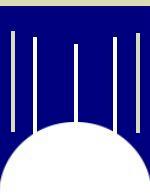 MAIN
MAIN
Our Officers
Our Patron
__________________
KNOWLEDGE BASE
W.O.R.P.
Published Articles
Masonic Lectures
Research Links
__________________
OTHER LINKS
H.I.S. Award
Masonic Graphics
Masonic Links
__________________
Lesson One
Tatenn Ra
"It is for each individual Mason to discover the secrets of Masonry,
by reflection upon its symbols and a wise consideration and analysis
of what is said and done in the work. Masonry labors to improve the
social order by enlightening men's minds, warming their hearts with
the love of the good, inspiring them with the great principle of
human fraternity, and requiring of its disciples that their language
and actions shall conform to that principle, that they shall
enlighten each other, and control their passions. To make honor and
duty the steady beacon-lights that shall guide your life-vessel over
the stormy seas of time; to do that which it is right to do, not
because it will insure you success, or bring with it a reward, or
gain the applause of men, or be "the best policy," more prudent or
more advisable; but because it is right, and therefore ought to be
done; to war incessantly against error, intolerance, ignorance, and
vice, and yet to pity those who err, to be tolerant even of
intolerance, and to teach the ignorant, are some of the duties of a
Mason."(Albert Pike)
In other words A SYSTEM OF MORALITY. What is a system? A system is a
group of components that interact to achieve a purpose. There are
many different kinds of systems such as biological systems,
astronomical systems, atomic systems, social systems, and so forth.
We practice a Morality System. What is the definition of moral? The
definition is good in character or conduct. It implies conformity to
the customary rules and accepted standards of society: He leads a
moral life. Morality is a system of morals; set of rules or
principles of conduct. Moral instruction in Freemasonry is veiled in
its allegorical legends, emblems and symbols.
It is said that this system of Morality is veiled. What does veil
mean? One definition is anything that screens or hides. So our
SYSTEM OF MORALITY IS SCREENED OR HIDDEN. SCREENED OR HIDDEN IN OR
BEHIND WHAT? ALLEGORY!
What is allegory? Allegory both conceals and reveals. It is the
written, oral, or artistic expression by means of symbolic fictional
figures and actions of truths or generalizations about human conduct
or experience. Fables, parables, and legends are allegories, and are
forms of imaginative literature or spoken utterance constructed in
such a way that their readers or listeners are encouraged to look
for meanings hidden beneath the literal surface of the fiction. The
wisdom of allegory, in all its many variations, is tied to the
development of myth and mythology. Every culture embodies its basic
assumptions in stories whose mythic structures reflect the society's
prevailing attitudes toward life. If the attitudes are disengaged
from the structure, then the allegorical meaning implicit in the
structure is revealed. In other words if we take what is being
actually said in the story away from the story then we have THE
GREAT MORAL TRUTHS. The fact is that the great moral truths of
Freemasonry are indestructible, and stand independent of the
symbolism intended to illustrate them when disengaged, isolated, or
separated from the symbolism. What symbolism do we use to illustrate
the great moral truths? Now check this out. Not only are great moral
truths veiled in allegory but they are illustrated by astronomical
symbols. As the sun is... As the sun is... As the sun is... Any
inquiry into the symbolic character of Freemasonry, must be preceded
by an investigation of the nature of symbolism in general, if we
would properly appreciate its particular use in the organization of
the Masonic Institution. We must have some knowledge of the science
of symbolism. The science which is engaged in the investigation of
the meaning of symbols, and the application of their interpretation
to moral, religious, and philosophical instruction. We can say that
Freemasonry is a system of morality developed and inculcated by the
science of symbolism. There is no science so ancient as that of
symbolism. Such is the system adopted in Freemasonry for the
development and inculcation of the great moral, religious, and
philosophical truths which are found in ALL the VOLUMES OF SACRED
LAW OF THE WORLD. The very essence of symbolical teaching consists
of the method of selecting some fact or some real object in nature,
art, or science, and by investing it with an emblematic significance
through comparison, thus teaching and illustrating some moral or
political doctrine. The anchor is thus made an emblem and
illustration of hope, the beehive of industry, the scythe of time or
death. A real anchor, beehive, or scythe is, however, required as a
foundation for this allegorical teaching. These are symbols. The
word symbol is derived from a Greek verb which signifies to compare
one thing with another; and hence a symbol or emblem, for the two
words are often used synonymously in Freemasonry, is the expression
of an idea derived from the comparison or attribute. The Plumb is a
symbol of rectitude; the level, of equality; the Beehive, of
industry. The physical qualities of the Plumb becomes to the
Freemason, after he has once been taught its symbolic meaning,
forever afterward the visible expression of the idea of rectitude,
or uprightness of conduct. To study and compare these visible
objects, to elicit from them the moral ideas which they are intended
to express, is to make one's self acquainted with the symbolism of
Freemasonry.
In Freemasonry, all the instruction in its mysteries are
communicated in the form of symbols. Founded, as a speculative
science, on an operative art, it has taken the working-tools of the
profession which it spiritualizes, the terms of architecture, the
Temple of Solomon, and everything that is connected with its
traditional history, and adopting them as symbols, it teaches its
great moral and philosophical lessons by this system of symbolism.
But its symbols are not confined to material objects. Its myths and
legends are also, for the most part, symbolic. Often a legend,
unauthenticated by history, distorted by anachronisms, and possibly
absurd in its pretensions if viewed historically or as a narrative
of actual occurrences, when interpreted as a symbol, is found to
impress the mind with some great spiritual and philosophical truth.
The legends of Freemasonry are parables, and a parable is only a
spoken symbol. Divine truths of Freemasonry are presented to the
neophyte in the various legends which have been traditionally
preserved. They may be divided into three classes: 1. the Mythical
Legend. 2. The Philosophical Legend. 3. The Historical Legend. The
three classes may be defined as follows:
1. The myth may be engaged in the transmission of a narrative of
early deeds and events having a foundation in truth, which truth,
however, has been greatly distorted and perverted by the omission or
introduction of circumstances and personages, and then it
constitutes the mythical legend.
2. Or it may have been invented and adopted as the medium of
enunciating a particular thought, or of inculcating a certain
doctrine, when it becomes a philosophical legend.
3. Or, lastly, the truthful elements of actual history may greatly
predominate over the fictitious and invented materials of the myth;
and the narrative may be, in the main, made up of facts, with a
slight coloring of imagination, when it forms a historical legend.
NEXT: Lesson 2
Back to Tatenn Ra Menu
|
|

|
|
|


